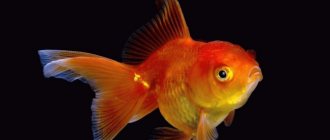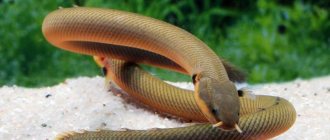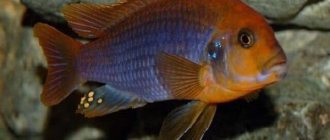This is an amazingly beautiful aquarium fish. Angelfish live in the wild in the rivers of South America. The Amazon and Orinoco basins are its natural habitat. There, in warm channels overgrown with aquatic plants, you can find the wild form of this fish, known to all aquarists.
These fish were brought to Europe at the beginning of the 20th century. Thus began the triumphant march of the angelfish. Now these fish are often found among aquarists all over the world. Specimens living in aquariums are color variations of the wild form that are obtained as a result of selection. There are a great many of them, all of them are distinguished by their extraordinary beauty. Among them is the extremely popular black angelfish.
Contents
Velvet angelfish do not need to be cut, walked, raised, or handled, which is one of the main advantages of aquarium fish. The Queen of Spades loves crystal clear water. That's why I change the water several times a week. She does not like bright light, so she mainly lives in the middle zone of the aquarium. The older and larger the velvet angelfish becomes, like its fellow species, the more intensively it makes attempts to choose its own private corner in the central part of the aquarium.
Black angelfish are not gourmets, as they happily eat any food - dry food, bloodworms, tubifex, shrimp. On Mondays I give the fish a fasting day to prevent the spread of various bacteria in the water and strengthen the immune system.
Description
Under natural conditions, wild angelfish are found in the basins of South American rivers. She prefers warm water and lots of vegetation in which to hide and feel safe.
In the last century, angelfish were brought to Europe. Today, this fish is a popular inhabitant of aquariums all over the world. There are a large number of species and color variations that have been bred from the wild form.
The body of the fish is tall, flattened laterally, similar in shape to a crescent. The anal and dorsal fins are long, pointed and slightly curved, resembling a sail. The pectorals are long and thin, like threads, slightly transparent on the sides. An adult can grow up to 20-25 cm in height and 16 cm in length. There is a veiled angelfish, the fins of which are even more elongated and develop in a train.
Veiled form of velvet angelfish.
The black angelfish has the main difference from other fish - color. A rich black velvet color without a single iridescent scale or light areas is the only correct appearance of the fish. However, it is difficult to find just such a representative, since the lack of constant selection leads to the fact that the breed loses its appearance.
Even a novice aquarist will be able to distinguish a female from a male at first glance. Males are larger, have a fleshy forehead and elongated sharp fins. Females are defined by their smaller size and round abdomen.
Advantages and disadvantages:
The advantages in favor of these aquarium fish include: easy care, unpretentiousness in nutrition, excellent behavior in a home aquarium, where aquatic inhabitants of different species live. All my attempts to find at least one flaw in the character, behavior, maintenance, and breeding of black angelfish turned out to be a losing fiasco for me. Therefore, I can safely say that angelfish are an excellent aquarium fish option for beginners and advanced aquarists.
Feeding
Due to its good appetite and reasonable pickiness in feeding, the angelfish has rightly received a reputation as an unpretentious fish for the aquarium. Regardless of which type of food for your pet will be cheaper, you should provide a nutritious, varied diet. The black angelfish will be grateful for such care - it will not get sick and try to eat the small inhabitants of the aquarium (guppies, neon fish). She needs to be given:
- Daphnia.
- Bloodworm.
- Artemy.
- Koretru.
- Plant food.
- Boiled fish.
- Dry food (should not predominate - only as an additive).
Many experts do not prohibit feeding frozen, combined food, but the main part of the diet is live, fresh organisms. One thing you need to know about quantity is that moderation never hurts. Angelfish must remain slightly hungry, otherwise they will experience digestive upsets. Such problems can lead to the death of pets, and it is important to remember this.
Behavior and character
Angelfish form permanent pairs. Since sexual differences are not expressed clearly, it is better to start a group of young fish - as they grow older, they choose their own partner. In large aquariums, several pairs can subsequently coexist, each of which will have its own section of territory. In small aquariums, one pair should be left. Angelfish are fairly peaceful fish; they get along well with other medium-sized fish and only show aggression during the spawning period. But despite its peaceful disposition, a hungry adult is not averse to swallowing small fish. Although it is not uncommon that angelfish, who grew up with neons from their youth, for example, did not touch them in the future.
Sedentary fish that do not tolerate pollution well. They are frightened by sudden, fast movements around the aquarium, and especially inside it, as well as by instantaneous strong changes in illumination. Can be kept in a community aquarium, preferably at least 40 cm high, but not with barbs that bite off their fins. Angelfish do not dig soil, do not damage plants, and love shelter in the form of long-stemmed plants and vertically located snags.
Diseases
Black velvet is susceptible to the following diseases:
- Mold infection;
- Rubella (gills, fins and even scales turn red);
- A fungal infection that causes the gills to disintegrate;
- Fin rot – fins begin to separate and disintegrate;
- Bacteria – bulging eyes, fear of light, lack of appetite, lethargy;
- Infection with flagellated protozoa, which leads to hexamitosis - the formation of ulcers on the head;
- Helminths - bloating with a standard diet.
Almost all diseases nowadays can be quickly cured, especially if the owner began to take measures at the initial stage.
Breeding
Breeding angelfish is not an easy task. For successful breeding, it is necessary to prepare a spawning tank. The water should be neutral and warm (28-30 degrees Celsius). Broad-leaved plants (echinodorus, cryptocarina) should be planted in the aquarium. If a male and female separate from the general group, they should be placed in a spawning aquarium. Further, the breeding process takes place without human intervention. Angelfish are excellent parents. Within two days, the female and the male clean the future spawning site (wide leaves of plants) from growths, food residues, and mucus.
Then the female begins to lay eggs on the leaves, and the male, following the female, fertilizes the eggs. For some time, the male and female remain at the spawning site, fanning the eggs with their fins, creating water circulation in the spawning site. Parents eat unfertilized or dead eggs. The fertilized eggs are transferred to another sheet. After 7-9 days, fry develop from the larvae. Parents “take” the fry for a walk. In the first days of life, the fry need to be fed with infusoria, pouring it into a spawning aquarium with water. Then switch to larger food - cyclops, brine shrimp. When the fry grow up, you can switch to small bloodworms and minced seafood. It is important not to overfeed the fry. Feed little by little, but often. Overeating can lead to the death of the fry.
Some breeding forms lack parental instincts. A significant factor is their inability to perform the correct spawning behavior for cichlids. They don't know what to do with the eggs and fry. This is due to the fact that after spawning the parents are removed to preserve more eggs. And the fry grow without parental supervision, like “incubator” ones.
Black angelfish compatibility
Black angelfish photo
By nature, angelfish are peaceful schooling fish, however, during the breeding season they become very aggressive. It easily gets along with peace-loving fish species: small tetras (neons, amanda tetras, etc.), they look good with swordtails. They go well with corydoras and small loricariid catfish.
Angelfish are incompatible with: guppies, goldfish. Although discus fish are also “relatives,” in our opinion, they are not the best neighbors for angelfish. Discus love warm water 30+, they are capricious, and grow into large fish. In general, we are in favor of keeping discus fish separately - in a species aquarium.
Varieties
There are three main types of angelfish:
- Common - the body is like a disk, the fins are like a sail.
- Leopolda is a rare species, with black stripes on the body and one extending onto the dorsal fin.
- Altum - distinguished by its large size (height up to 0.5 in nature), a depression between the forehead and mouth. It has four transverse black stripes and red dots on the fins.
Many varieties have been bred from them.
| Name | Peculiarities |
| Diamond |
How to raise fry
Individuals aged 10–12 months are considered adults. Before this, immediately after birth, they are fed ciliates, rotifers and brine shrimp. They are grown from dry eggs available in every pet store. This is the best option for feeding up to 1 month of life of the fry. Then you can give daphnia and special food for fry. From 3 months they give chopped bloodworms, and from 6 months - complete food for adults.
Thus, beautiful black angelfish are not only unpretentious in keeping, but also not too demanding of neighbors, food and breeding conditions. Purchased once, they are capable of pleasing the eye of the owner for a whole decade, who monitors the aeration of the water and does not forget to feed the fish on time.
Appearance
By origin, angelfish are cichlids that live in the warm waters of Brazil and South America. The body shape is arrow-shaped or crescent-shaped. The body itself is flat on the sides and almost round, and the fins give it angularity. They look like sails. The upper and lower ones are usually the same size, protruding strongly above the body. Some breeds have particularly elongated outer rays on all fins: caudal, dorsal and anal. Also, almost all angelfish have very long rays on their pelvic fins: this is a kind of calling card of angelfish.
Living in the wild
Angelfish is a freshwater tropical fish. The fish prefers slow-moving waters in South America: in the central basin of the Amazon River and its tributaries in Peru, Brazil and Colombia. In particular, the Ucayali River in Peru, the Oyapoc River in French Guiana, the Essequibo River in Guyana, the Solimões, Amapá and Amazon Rivers in Brazil. It is found in swamps or flooded lands where the vegetation is dense and the water is clear or cloudy. Water parameters vary from pH 6.0 to 7.0, water hardness from 3 to 10 °dH, and water temperature ranges from 26 to 30 °C.
In the wild, the fish live in densely planted areas where they feed on juvenile fish, insects, invertebrates and plants. They prefer ponds and rivers with slow flows and dense vegetation. The reservoirs in which angelfish live are characterized by warm, soft and slightly acidic water.
The flattened shape of the body allows them to easily maneuver among thickets of underwater plants, and the vertical dark stripes make them less noticeable to predators. In nature, fish usually gather in small schools.
Difficulty in content
Of average complexity, but not recommended for beginner aquarists, as they require decent volumes, stable water parameters and can be aggressive towards small fish. In addition, they hunt fry and small shrimp with remarkable dexterity. If there is a lack of experience in keeping them, they die or actively eat other fish, causing negative feelings in the novice aquarist.
They themselves may also suffer from fish that break off their fins, such as Sumatran barbs and thorns.
History of domestication
Ferdinand Schulz described the angelfish in 1823 and gave it the name Zeus scalaris. The famous Austrian zoologist named it in 1840 - Pterophyllum, which means “winged leaf” from Latin. Georges Cuvier described and named the fish Platax sciaris in 1931.
It was possible to bring fish to Germany in 1911; before they died. In 1914, they were propagated artificially for the first time; details were not disclosed until 1920, then aquarium hobbyists began breeding angelfish everywhere. It came to the USA in 1930. In the second half of the 20th century, breeders developed many breeds of this species.











